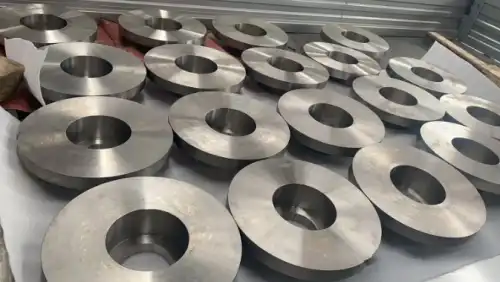Titanium and its products (such as rods, tubes, and plates) are widely used in aerospace, chemical engineering, and medical applications due to their excellent strength-to-weight ratio and outstanding corrosion resistance. This corrosion resistance is largely attributed to the protective oxide film that forms on its surface. However, the reaction behavior of titanium with the main components of air—oxygen (O₂), nitrogen (N₂), and hydrogen (H₂)—is highly dependent on ambient temperature. Understanding this temperature dependence is crucial for safe use and predicting material properties.

Mechanisms of Temperature Effects on the Titanium-Oxygen Reaction
1. Low-Temperature Stability (Room Temperature to ~500°C):
Within this temperature range, dense titanium products (such as rods, tubes, and plates) react extremely slowly in air.
The titanium surface reacts with oxygen, and the oxygen atoms gradually integrate into the titanium surface lattice structure, forming a thin, dense oxide film (primarily composed of titanium dioxide TiO₂).
This oxide film is crucial, acting as a physical barrier, effectively preventing further diffusion of external oxygen into the titanium matrix. Therefore, dense titanium exhibits good stability in air below 500°C. At this point, the color of the surface oxide film changes regularly (e.g., from light yellow to blue) as the formation temperature increases, providing a visual indicator of changes in thickness and structure.
2. Intermediate-Temperature Transition Zone (approximately 500°C to 700°C):
As the temperature rises above 500°C, the surface oxide film begins to undergo significant changes.
The solubility of the oxide film in the titanium matrix increases, and portions of the film begin to dissolve.
Oxygen begins to diffuse through the oxide film into the titanium metal, but the diffusion rate is relatively slow.
Key Point: Before 700°C, oxygen diffuses primarily into the surface areas of the metal and generally has not yet penetrated deeply into the metal's internal lattice. Although the oxide film is weakened, it still provides some protection.
3. High-Temperature Accelerated Reaction (above 700°C):
When the temperature exceeds the critical point of 700°C, the reaction kinetics undergo a significant shift.
The diffusion rate of oxygen into the titanium metal accelerates dramatically.
The titanium oxide film formed on the surface becomes loose and porous, or dissolves at a rate far greater than its formation rate, completely losing its protective effect.
At this point, oxygen (as well as nitrogen and hydrogen in the air) can freely and violently react with the titanium matrix, causing significant oxidation, embrittlement (caused by oxygen and nitrogen infiltration), and even hydrogen embrittlement (caused by hydrogen infiltration), severely degrading the material's properties.
The Influence of Morphology: The Special Characteristics of Powdered Titanium
The physical form of titanium products has a decisive influence on their reactivity:
Dense titanium (blocks, rods, tubes, plates): As mentioned above, it is stable in room temperature air and relies on the protection of the surface oxide film. Its high-temperature behavior follows the temperature grading rules described above.
Powdered titanium: It has a very large specific surface area and is extremely reactive.
In room temperature air, fine titanium powder is very sensitive to static electricity, mechanical sparks, or friction, and can violently burn or even explode.
Its low reaction activation energy means that once ignited, it burns rapidly and violently, in stark contrast to the low-temperature stability of dense titanium. When handling titanium powder, strict safety regulations regarding explosion, fire, and static electricity must be adhered to.
Conclusion
The reaction processes of titanium products in air (primarily with oxygen) are inherently highly temperature-dependent. The stability of dense titanium below approximately 500°C depends on the protective oxide film formed on its surface. Between 500 and 700°C, this protective film gradually weakens, allowing oxygen diffusion to begin. Above 700°C, the protective film loses its effectiveness, rapidly accelerating oxygen diffusion and causing severe oxidation and embrittlement. Furthermore, titanium powder, due to its large surface area, exhibits extremely high reactivity and combustion and explosion risks at room temperature, a behavior distinct from that of dense titanium.
A deep understanding of the crucial influence of temperature on titanium-gas reactions (especially titanium-oxygen reactions) is fundamental for selecting the appropriate temperature range for titanium products, evaluating their long-term performance in high-temperature environments, and safely handling titanium materials of various forms (especially powders). In any high-temperature application involving titanium, strict control of ambient temperature is paramount to maintaining material integrity and safety.











